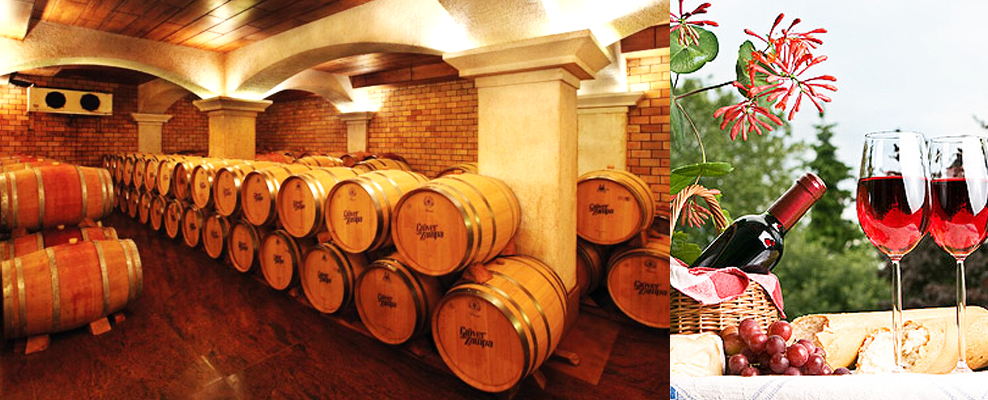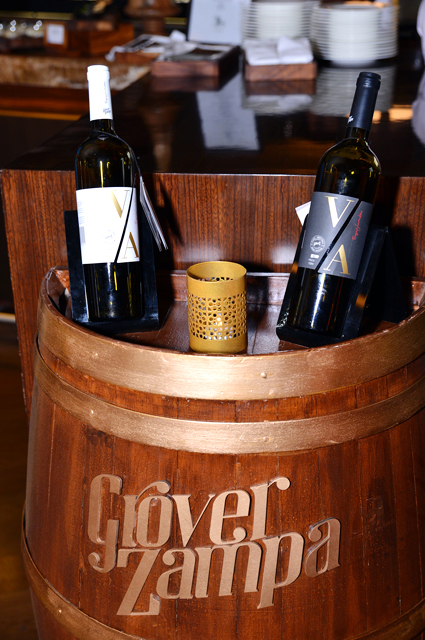
WoT's Hot
I’d experienced my first delightful wine tasting session in South Africa, several years ago. With a day to spare in Bangalore, I therefore agreed to my friend’s proposal of visiting Grover Zampa winery without a moment’s hesitation. We reserved our places for the tour online, paid Rs.850/- per head and taking the NH5, headed out of Bangalore towards Nandi Hills. GPS and a two hour plus drive got us past the concrete jungle into vast tracts of open land and after crossing wine yards and farms we reached Zampa Grover Winery, where the eponymous wine is actually made.
We were greeted by ample greenery and quiet along with a smiling tour guide named Vipin who escorted us towards the lounge for refreshments. No, not wine yet, but much needed coolers and thirst-quenchers. The two of us being the only visitors, our tour started pronto. Over the next one and a half hours, vipin took us through the various stages of both red and white wine being produced, right up to their final stages. Photography though remained strictly prohibited, ensuring secrecy.
Vipin tells us that Grover’s is the second-largest wine maker in the country (Sula being the largest) and was founded by Kanwal Grover in the 1960’s. Thereafter, his son, Kapil Grover took over who is now aided by his daughter, Karishma Grover. Their wine consultant however, continues to be senior French oenologist by the name of Michel Rolland.

Chit chatting, we reach a point where the grapes have been offloaded from trucks for meticulous sorting and then crushing. In the case of white wine, they are also de-stemmed well and only the juice is retained through a process called balloon pressing. In the case of red wines we learn, that the entire grape with its skin and pulp are crushed. The juice is then sent for fermenting in giant steel tanks that can hold upto 25,000 litres of liquid. These tanks are placed in closely monitored temperature controlled chambers that vary for red and white. Once again, we learn that the fermentation period is 21 days for the white and lesser for the red. This entire process is a delicately monitored one that ensures the high quality of wine and turns the grape into alcohol. At the end of this period, the yeast gathers at the bottom of the tank, that is extracted and the wine is then sent for filtering. All of this is done via sophisticated machines under the watchful eyes of managers who are highly trained. Every department has its own skilled staff. The winery also has an in-house lab for R&D and testing. Once the wines are sent for ageing, they are de crystallised once more, before they are finally sent for bottling.
Of course, we understand that Vipin has given us an overview of wine making as the process involved several other detailed nuances that have to be kept in mind to ensure consistency and quality. The winemaking process ends with the bottling and labelling section, the last being the only bit that we saw being done manually.

The tour had promised us a wine tasting session and having undergone the elaborate tutorial, we can’t wait to start the Zampa Grover labels. We are taken to a cold, ambient barrel room, full of real oak barrels where a wine tasting set up is ready. We try out both whites and reds, including Grover’s award winning La Reserve, which of course we save for the last. Pictures are finally permitted though the light in the room doesn’t quite make for the best shots. Vipin continues to enlighten us on wine tasting: see the colour and check for clarity, smell the wine and finally take a sip. Some useful tips that we gather while tasting include how all wines must be kept away from light to avoid being ‘light struck’; how they must be stored on the side and not upright and how the temperature must never go below 24degrees Celsius or the wine begins to oxidise.
As a thumb rule, he also states the basic nature of each wine: Riesling is limey, Chardonnay smells like peaches, Shiraz is peppery, Cabernet Sauvignon smells like blackcurrants, Chenin Blanc smells like honey and lemon, Sauvignon Blanc is herbaceous with ripe tropical fruits and Viognier is predominant apricot with floral notes. Pictures, wine and cheese done, we come to the end of our tour and return to the lounge for a sumptuous, freshly cooked meal of biryani with raita. The slumber post the tour, the tasting and the carbs is hard to fight and we can’t wait to get back to town for a nap. And of course to try out the wines we picked on the way out with all our newly learnt skills and experience.
The next time you are in Bangalore and have a spare day, don’t go pubbing in the evening. Instead, despite the heat, take a tour of one of India’s best wine brands and understand the detailing it takes to make the wine you regularly sip. You’ll certainly sip it with far greater awareness and appreciation!
I’d experienced my first delightful wine tasting session in South Africa, several years ago. With a day to spare in Bangalore, I therefore agreed to my friend’s proposal of visiting Grover Zampa winery without a moment’s hesitation. We reserved our places for the tour online, paid Rs.850/- per head and taking t
Other Articles in India
What to read next
Featured articles

Welcome Festive Season in Glam, Latin Quarters Launches new #PujoBling Collection with Monami Ghosh
by WOT









































